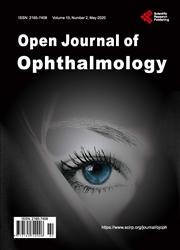Safety and Efficacy of Artisan Aphakia Iris-Claw Intraocular Lens in Tertiary Hospital in Indonesia
引用次数: 0
Abstract
Introduction: Iris-claw Intraocular Lens (IOL) is one of the alternatives to correct aphakia without sufficient capsular support. This technique is preferred because it has a simple procedure. Iris-claw IOL was originally designed to be fixated on the anterior chamber. The use of retropupillary fixation is increasing because the location is more physiologic and it shows less risk to corneal endothelial damage. Purpose: To describe safety and efficacy of iris-claw Artisan IOL in correcting aphakia without sufficient capsular support. Methods: This is a descriptive retrospective study of patients with aphakic iris-claw Artisan IOL implantation in National Eye Center Cicendo Eye Hospital, Indonesia from July 2017-July 2019. Patients were divided into prepupillary and retropupillary group. The Uncorrected Visual Acuity (UCVA), Best-Corrected Visual Acuity (BCVA), Safety Index (SI), Efficacy Index (EI), and complications were recorded. The procedure is safe if SI value ≥ 1.0 and effective if EI value ≥ 1.0. Results: There were 54 eyes in the retropupilary group and 17 eyes in the prepupillary group. In the prepupillary group, there were 94.11% eyes with SI ≥ 1.0, the mean SI was 1.79 ± 1.02, 50% of eyes with EI ≥ 1.0, and the mean EI was 0.77 ± 0.20. In the retropupillary group, there were 96.29% eyes with SI ≥ 1.0, the mean SI was 2.49 ± 2.23, 74.07% of eyes with EI ≥ 1.0, and the mean EI was 1.75 ± 1.64. Postoperative UCVA and BCVA were improved significantly compared to preoperative visual acuity in both groups (p < 0.05) Conclusion: Prepupillary and retropupillary iris-claw IOL implantation are safe. Retropupillary fixation technique is more effective in improving visual acuity.印度尼西亚三级医院手工无晶状体虹膜爪人工晶状体的安全性和有效性
引言:虹膜爪人工晶状体(IOL)是在没有足够囊膜支撑的情况下矫正无晶状体眼的替代方案之一。这种技术是首选的,因为它有一个简单的程序。虹膜爪人工晶状体最初设计用于固定在前房上。瞳孔后固定的使用越来越多,因为其位置更具生理性,对角膜内皮损伤的风险更小。目的:描述虹膜爪Artisan人工晶状体在没有足够囊膜支撑的情况下矫正无晶状体眼的安全性和有效性。方法:这是一项描述性回顾性研究,对2017年7月至2019年7月在印度尼西亚国家眼科中心Cicendo眼科医院进行的无晶状体虹膜爪人工晶状体植入术的患者进行研究。患者分为瞳孔前组和瞳孔后组。记录未矫正视力(UCVA)、最佳矫正视力(BCVA)、安全性指数(SI)、疗效指数(EI)和并发症。如果SI值≥1.0,该程序是安全的,如果EI值≥1.0则有效。结果:瞳孔后组54眼,瞳孔前组17眼。在前瞳孔组中,94.11%的眼睛的SI≥1.0,平均SI为1.79±1.02,50%的眼睛的EI≥1.0,并且平均EI为0.77±0.20。瞳孔后组SI≥1.0者占96.29%,平均SI为2.49±2.23,EI≥1.0者为74.07%,平均EI为1.75±1.64。与术前相比,两组术后UCVA和BCVA的视力均有显著提高(p<0.05)。结论:瞳孔前和瞳孔后虹膜爪人工晶状体植入术是安全的。瞳孔后固定技术在提高视力方面更为有效。
本文章由计算机程序翻译,如有差异,请以英文原文为准。
求助全文
约1分钟内获得全文
求助全文

 求助内容:
求助内容: 应助结果提醒方式:
应助结果提醒方式:


